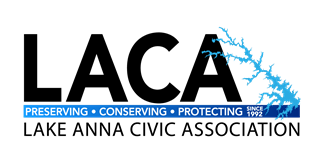By Al Bennett - November 2020
November is a significant month for Lake Anna’s aquatic life and continued good water quality. It is the time of the year when the lake “turns over”, meaning the internal workings of the lake completely mix the water throughout the entire depth of the lake, sometimes referred to as the water column. This mixing brings much needed oxygen from the surface water region (scientific term is epilimnion) to the lake’s bottom layer (hypolimnion). Likewise, the nutrients that have been generated and are present at the lake’s bottom are released throughout the water column.
To understand how and why the lake mixes, one must first understand the relationship between water temperature and its density. Water possesses a unique property in that it is most dense and therefore the heaviest when its temperature is 39.2 degrees. Above and below this temperature, water is less dense. See the below table for the weight of a gallon of water at various temperatures.
 In the summer months and in the mid to lower section of the lake where water depth exceeds 40 feet, the lake becomes stratified into three layers where the water temperature within each layer is relatively constant. See the below table. In June and for the first 40 feet or so it is not uncommon for the water temperature to be about 81 degrees at the surface and roughly 74 degrees at the 40 foot level. Another layer (metalimnion), commonly referred to as the thermocline, extends down to a depth of about 60 ft where the temperature at that depth is on the order of 63 degrees. Below the 60 ft level, water temperature drops to approximately 60 degrees at the deepest part of the lake.
In the summer months and in the mid to lower section of the lake where water depth exceeds 40 feet, the lake becomes stratified into three layers where the water temperature within each layer is relatively constant. See the below table. In June and for the first 40 feet or so it is not uncommon for the water temperature to be about 81 degrees at the surface and roughly 74 degrees at the 40 foot level. Another layer (metalimnion), commonly referred to as the thermocline, extends down to a depth of about 60 ft where the temperature at that depth is on the order of 63 degrees. Below the 60 ft level, water temperature drops to approximately 60 degrees at the deepest part of the lake.
Lake stratification slowly disappears in the mid to upper region of the lake. At The Splits (North Anna River/Pamunkey Creek) and above, the lake becomes shallower and the water temperature is uniform throughout the water column.

As the season transitions from summer to fall, the surface water becomes increasing cooler. As it cools, it becomes denser (heavier) thereby, displacing the water at lower depths. By about mid November, the water temperature at the surface near the dam and at a depth of 69 feet will be about the same, approximately 62 degrees.


Throughout the fall and winter, the water will become colder within the water column; however, the variation in temperature will be minimal. Since there is minimal temperature variation, nutrients and oxygen travel freely within the water column. Wind assists with water circulation. Come late spring, the lake’s surface layer will begin to warm and by the summer, the lake will once again be stratified where oxygen within the highly oxygenated top layer and the nutrients in the nutrient rich bottom layer will remain “trapped” until the lake “turns over” again in November 2021.
